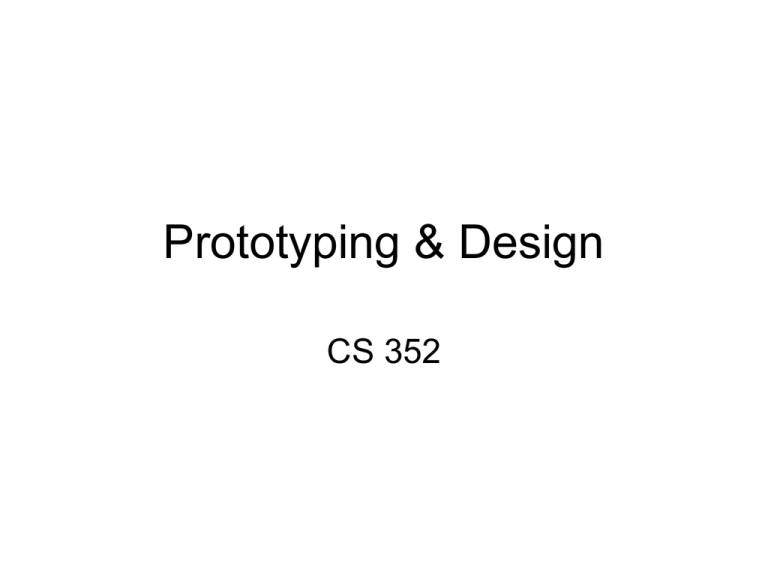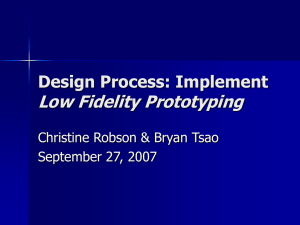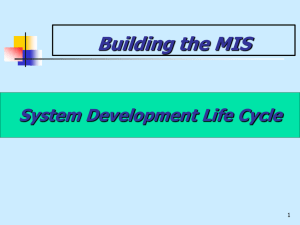Prototyping & Design CS 352
advertisement

Prototyping & Design CS 352 Where we are… • We have talked about: – How to study users • Ethnography • Surveys • Interviews – How to structure that data • Use Cases/Scenarios • Hierarchical Task Analysis – How to interpret data • So, what do we do with this knowledge? What is a prototype? In other design fields a prototype is a small-scale model: a miniature car a miniature building or town Something you plan to throw away! What is a prototype? In interaction design it can be (among other things): • a series of screen sketches • a storyboard, i.e. a cartoon-like series of scenes • a Powerpoint slide show • a video simulating the use of a system • a lump of wood (e.g. PalmPilot) • a cardboard mock-up • a piece of software with limited functionality Why prototype? Facilitates evaluation and feedback • Stakeholders can see, hold, interact with a prototype more easily than with a document • Team members can communicate more effectively • You can test out ideas for yourself • Encourages reflection • Prototypes answer questions, and support designers in choosing between alternatives What to prototype? • Work flow, task design • Screen layouts and information display • Difficult, controversial, critical areas Compromises in prototyping • All prototypes involve compromises • For software-based prototyping maybe there is a slow response? Low-fidelity icons? limited functionality? • Two common types of compromise • ‘horizontal’: provide a wide range of functions, but with little detail • ‘vertical’: provide a lot of detail for only a few functions Low-fidelity Prototyping • Uses a medium which is unlike the final medium, e.g. paper, cardboard • Intentionally rough and unfinished • Is quick, cheap and easily changed (?) • Encourages “high-level” criticism; problems with conceptual models and fundamental usability/functionality issues Low-fidelity prototype Storyboards •Often used with scenarios, bringing more detail, and a chance to role play •It is a series of sketches showing how a user might progress through a task using the device Storyboards Interactive Prototyping • Extreme prototyping! • Going with the flow Low-fidelity Prototype Evaluation • Formative evaluations – Wizard of Oz studies – GOMS and action analysis – Cognitive walkthroughs – Heuristic evaluations High-fidelity prototyping • Prototype looks and behaves like (subset of) the final system • Commonly used tools: Macromedia Director, Visual Basic, and Smalltalk. • Users may think they have a full system (problem!) • Get at details of design (layout, icons, colors etc) Low Fidelity to High Fidelity Abandoned Prototype Medium-fidelity prototypes (?) • Somewhere in-between • Typically high production values, no/limited interaction – Powerpoint mock-ups – Photoshop • Tests detail of design without committing • Because no functionality, less pressure from users Prototype and Evaluation Early design Rough out on paper Low-fidelity (paper-based) Cognitive walkthrough Formative evaluation Action analysis Medium-fidelity Heuristic evaluation Functional prototype High-fidelity (computer-based) Empirical studies Late design Low Fidelity to High Fidelity Low Fidelity to High Fidelity Low Fidelity to High Fidelity Low Fidelity to High Fidelity Design Gallery • Make a poster showing – Your basic system/UI – Your use-case (what you’re going to evaluate) – Your current status


